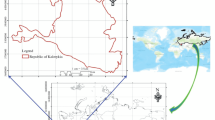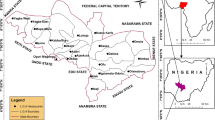Abstract
Demand for groundwater for drinking, agricultural and industrial purposes has increased due to uncertainty in the surface water supply. Agriculture is the main occupation of the rural people in Guntur district, Andhra Pradesh, India. Development of groundwater in the district is very less, indicating a lot of scope for further development of groundwater resources. However, assessment of groundwater conditions, particularly in a crystalline terrain, is a complex task because of variations in weathering and fracturing zones from place to place. Systematic studies for evaluation of groundwater potential zones have been carried out in a crystalline terrain of the district. Information on soils, geological formations and groundwater conditions is collected during the hydrogeological survey. Topographical and drainage conditions are derived from the Survey of India topographical maps. Geomorphological units and associated landform features inferred and delineated from the Indian remote sensing satellite imagery (IRS ID LISS III FCC) are moderately buried pediplain (BPM), shallow buried pediplain (BPS), valley fills (VF), structural hill (SH), residual hills (RH), lineaments and land use/land cover. A groundwater potential index (GPI) is computed for relative evaluation of groundwater potential zones in the study area by integrating all the related factors of occurrence and movement of groundwater resources. Accordingly, the landforms, BPM, BPS, VF, SH and RH, of the area are categorized as very good groundwater potential zone, good to moderate groundwater potential zone, moderate to poor groundwater potential zone, poor to very poor groundwater potential zone and very poor groundwater potential zone, respectively, for development and utilization of both groundwater and surface water resources for eliminating water scarcity. This study could help to improve the agrarian economy for better living conditions of the rural people. Taking the total weight-score of the GPI into account, a generalized classification of groundwater potential zones is evaluated for a quick assessment of the occurrence of groundwater resources on regional scale.










Similar content being viewed by others
References
CGWB (1994) Groundwater resources and development prospects in Guntur District, Andhra Pradesh. Central Ground Water Board Technical Report, South India
Chakraborty S, Paul PK (2004) Identification of potential groundwater zones in the Baghmundi block of Purulia district of West Bengal using remote sensing and GIS. J Geol Soc India 64:69–75
Nag SK, Surajit Ch (2003) Influence of rock types and structures in the development of drainage network in hardrock area. J Indian Soc Remote Sens 31:25–35
Sankar K (2002) Evaluation of groundwater potential zones using remote sensing data in Upper Vaigai river basin, Tamil Nadu, India. J Indian Soc Remote Sens 30:119–129
Sener A, Davraz A, Ozcelik M (2005) An integration of GIS and remote sensing in groundwater investigations: a case study in Burdur, Turkey. Hydrogeol J 13:826–834
Sreedevi PD, Subrahmanyam K, Ahmed Sh (2005) Integrating approach for delineating potential zones to explore for groundwater in the Pageru river basin, Cuddapah district, Andhra Pradesh, India. Hydrogeol J 13:534–543
Subba Rao N (1992) Factors affecting optimum development of groundwaters in crystalline terrain of the Eastern Ghats, Visakhapatnam area, Andhra Pradesh, India. J Geol Soc India 40(5):462–467
Subba Rao N (2006) Seasonal variations of groundwater quality in a part of Guntur district, Andhra Pradesh, India. Environ Geol 49:413–429
Subba Rao N, Prathap Reddy R (1999) Groundwater prospects in a developing satellite township of Andhra Pradesh, India using remote sensing techniques. J Indian Soc Remote Sens 27:193–203
Subba Rao N, Chakradhar GKJ, Srinivas V (2001) Identification of groundwater potential zones using remote sensing techniques in and around Guntur town, Andhra Pradesh, India. J Indian Soc Remote Sens 29:69–78
Acknowledgements
The author is grateful to the Department of Science and Technology, Government of India, New Delhi 110 016, India, for providing financial assistance under Major Research Project (ESS/72/023/98) entitled “Assessment and Management of Groundwater Resources in a Part of Crystalline Terrain of Guntur District, Andhra Pradesh, India” during 1999–2002. The author is also thankful to Mr. D. John Devadas, DST-Research Scholar (1999–2002), Department of Geology, Andhra University, Visakhapatnam 530 003, India, for his assistance in the field as well as in the laboratory work. The author is also thankful to Mr. I. Bangaru Raju, Research Scholar, Department of Geology, Andhra University, Visakhapatnam 530 003, India, for his help during the preparation of high-quality computer graphics. The valuable comments made by the anonymous referees were useful for improving this manuscript.
Author information
Authors and Affiliations
Corresponding author
Rights and permissions
About this article
Cite this article
Subba Rao, N. Groundwater potential index in a crystalline terrain using remote sensing data. Environ Geol 50, 1067–1076 (2006). https://doi.org/10.1007/s00254-006-0280-7
Received:
Accepted:
Published:
Issue Date:
DOI: https://doi.org/10.1007/s00254-006-0280-7




